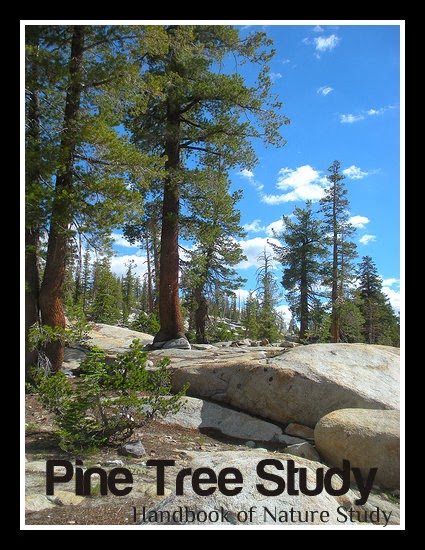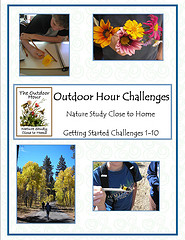This may be a difficult focus since everyone has different kinds of trees in their area but I am going to attempt to cover a variety just to get you started and to show you how the Handbook of Nature Study can help you in your local area. I used the poll on my sidebar to gather data about what trees would be an appropriate choice for each challenge.
This week we will start with pines since 87% of those polled in my recent survey responded that they had pines in their location. The Handbook of Nature Study highly recommends studying at least one kind of pine tree in the field and then the leaf/needle or the cone indoors, one specimen per child. I realize that not everyone will have the ability to study a pine tree up close so do the best you can. Even if you do not have any pine trees in your area, you can still start to learn the difference between evergreens and deciduous trees.
Here is a link that will introduce the difference between deciduous and evergreens: EHow.Com.
Here is a web page that has lists of pines by region-worldwide! Make sure to scroll down to find your particular area.
Answers.com-List of Pines
Outdoor Hour Challenge #32
Trees-Pines
1. This week read in the Handbook of Nature Study pages 670-675 to learn more about pine trees. Even if you don’t think you have any pines in your area, it is still interesting to read the information for future reference. Make sure to note the ideas suggested for studying pines in the lesson at the end of the section.
2. Spend 15 minutes outdoors this week with your children in your own yard or on your own street. This week you will have two suggested activities.
*If you have a pine tree of any variety in your yard or on your street, use the ideas from the lesson on page 674 and 675 to guide your observation of the pine tree.
Some ideas to get you started:
What is the general shape of the pine tree?
Is there one central stem running straight up through the center of the tree to the top?
What color is the bark? Is the bark ridged or in scales?
Study the pine leaves. Why are they called needles? How many needles in the bundle?
Does it have a cone?
*If you do not have a pine to observe or you would like an additional activity, take some time to lay under any kind of tree that is available. Look up at the branches. Listen to the sounds of the leaves. Try to spot some kind of wildlife in the tree. Have your children tell you with their words what they experienced while under the tree.
3. After your outdoor time, spend a few minutes discussing any trees you saw. Talk about anything that interested your child. Maybe they brought home a leaf or a cone to examine and you could look at them with a magnifying lens. This would be a good time to look up any pine trees you observed in your field guide and see if you can learn more about your particular pine tree.
4. Make sure to give time and the opportunity for a nature journal entry. If you observed a pine tree, try to complete exercise 10 of the lesson on pine trees: Draw a bundle of pine needles showing the sheath and its attachment to the twig; the cone; the cone scale; the seed. Sketch a pine tree. You could also include a leaf or needle rubbing in your nature journal this week.
5. If you identified a tree this week, add it to your list of trees in the front or back of your nature journal. You can also use the Running List notebooking page. Make a note indicating whether it is an evergreen or a deciduous tree.
You can purchase all of the first ten challenges in a convenient ebook along with custom notebook pages.



This one looks like fun, and we have perfect weather for it right now. 🙂 Sure, we’d love for you to use one of our pics on your site! I really liked the ones of the boys sketching outside, too. Thanks!
Barb–Thanks for all your hard work!
Congrats on the 624 outdoor challenges! Very inspiring. Thanks for all you do, Barb!
-Heather
624!!! Wow!! I am pleased to be a part of the evolution… 😀
This was so much fun! We loved it! Thanks!
This was a great study…and now we have lots of pretty pine cones for our fall decorations. 😉
After lurking for some time… we finally jumped in and had a lot of fun. Thanks for organizing this.
It is so good to be back! This is a great challenge. As always, thanks for the inspiration!
Thanks again Barb for all you do!!!!! Your awesome!!We are loving these tree nature studies!! Be blessed!-Angie in GA
I love that I can identify so many of the plants and trees that we see on our walks now. Each week we add more and more to our lists of known flora.
We’re planning on doing the fall tree study this week, so I thought I’d post our pines here. We’re a little behind on typing up our tree studies, but we’re doing them! We had a wonderful time hiking to the bristlecone pines at Great Basin Nat’l Park a few weeks ago and I wanted to make sure that experience made it into a post.
Thanks for all your encouragement.
The co-op class did pine trees with me two weeks ago, I added pine needle tea, it went over very well.
We enjoyed doing a nature study about the white pine as part of learning about Maine’s state tree. It seems like we learn something new each time we do a nature study!